#alzheimer's foundation
Text

SCP Aesthetics: 3890 (requested by @dewnose2, written by @tanhony)
My name is Elizabeth Graham. My name is Elizabeth Graham. My name is Elizabeth Graham. I can't forget that now. This page is my memory.
(blue, memory, doubles)
requests are open.
#scp#scp foundation#scp aesthetics#3890#this one is neat!!#cool evolution#big ol tw for alzheimers and memory discussions tho
26 notes
·
View notes
Text
Solomon Carter Fuller, M.D., a Black Mental Health Pioneer
Solomon Carter Fuller, M.D., the first known Black psychiatrist in America and an early pioneer in the fight against Alzheimer's. Dr. Fuller collaborated with Dr. Alois Alzheimer, identifying the disease we now know as Alzheimer's, and helped translate much of his work from German to English.
Sources: Patch.org, American Psychiatric Association Foundation, and Melvin Sabshin, MD Library and Archives
Visit www.attawellsummer.com/forthosebefore to learn more about Black history.
Need a freelance graphic designer or illustrator? Send me an email.
#Solomon Carter Fuller#psychiatrist#medical research#Alzheimer's#Alois Alzheimer#psychiatry#Black mental health pioneers#health pioneers#mental health#American Psychiatric Association Foundation#dementia#APA#Black history#American history#Black doctors
4 notes
·
View notes
Note
i get what ur saying but it’s very funny you’re angry at Arin all while advertising an event made by Idubbbz who has a 30x worse reputation. I still agree with u tho both of them got their ass beat
the event was for charity dumbass I don’t give a fuck about idubbbz
#txt#i don’t give a shit about arin and I don’t give a shit you agree with me LOL#money went towards a heart/Alzheimer’s foundation/pet therapy group stupid
2 notes
·
View notes
Text
How a mutation in microglia elevates Alzheimer’s risk
New Post has been published on https://thedigitalinsider.com/how-a-mutation-in-microglia-elevates-alzheimers-risk/
How a mutation in microglia elevates Alzheimer’s risk
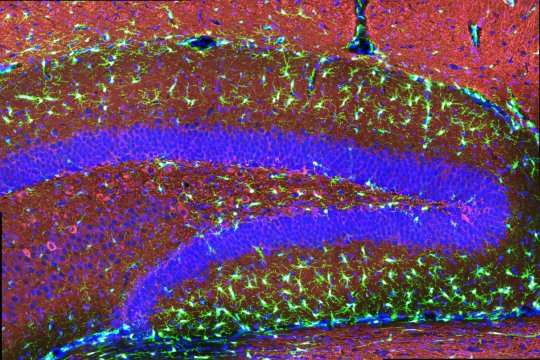

A rare but potent genetic mutation that alters a protein in the brain’s immune cells, known as microglia, can give people as much as a threefold greater risk of developing Alzheimer’s disease. A new study by researchers in The Picower Institute for Learning and Memory at MIT details how the mutation undermines microglia function, explaining how it seems to generate that higher risk.
“This TREM2 R47H/+ mutation is a pretty important risk factor for Alzheimer’s disease,” says study lead author Jay Penney, a former postdoc in the MIT lab of Picower Professor Li-Huei Tsai. Penney is now an incoming assistant professor at the University of Prince Edward Island. “This study adds clear evidence that microglia dysfunction contributes to Alzheimer’s disease risk.”
In the study in the journal GLIA, Tsai and Penney’s team shows that human microglia with the R47H/+ mutation in the TREM2 protein exhibit several deficits related to Alzheimer’s pathology. Mutant microglia are prone to inflammation, yet are worse at responding to neuron injury and less able to clear harmful debris, including the Alzheimer’s hallmark protein amyloid beta. And when the scientists transferred TREM2 mutant human microglia into the brains of mice, the mice suffered a significant decline in the number of synapses, or connections between their neurons, which can impair the circuits that enable brain functions such as memory.
The study is not the first to ask how the TREM2 R47H/+ mutation contributes to Alzheimer’s, but it may advance scientists’ emerging understanding, Penney says. Early studies suggested that the mutation simply robbed the protein of its function, but the new evidence paints a deeper and more nuanced picture. While the microglia do exhibit reduced debris clearance and injury response, they become overactive in other ways, such as their overzealous inflammation and synapse pruning.
“There is a partial loss of function, but also a gain of function for certain things,” Penney says.
Misbehaving microglia
Rather than rely on mouse models of TREM2 R47H/+ mutation, Penney, Tsai, and their co-authors focused their work on human microglia cell cultures. To do this they used a stem cell line derived from skin cells donated by a healthy 75-year-old woman. In some of the stem cells they then used CRISPR gene editing to insert the R47H/+ mutation and then cultured both edited and unedited stem cells to become microglia. This strategy gave them a supply of mutated microglia and healthy microglia, to act as experimental controls, that were otherwise genetically identical.
The team then looked to see how harboring the mutation affected each cell line’s expression of its genes. The scientists measured more than 1,000 differences, but an especially noticeable finding was that microglia with the mutation increased their expression of genes associated with inflammation and immune responses. Then, when they exposed microglia in culture to chemicals that simulate infection, the mutant microglia demonstrated a significantly more pronounced response than normal microglia, suggesting that the mutation makes microglia much more inflammation-prone.
In further experiments with the cells, the team exposed them to three kinds of the debris microglia typically clear away in the brain: myelin, synaptic proteins, and amyloid beta. The mutant microglia cleared less than the healthy ones.
Another job of microglia is to respond when cells, such as neurons, are injured. Penney and Tsai’s team co-cultured microglia and neurons and then zapped the neurons with a laser. For the next 90 minutes after the injury the team tracked the movement of surrounding microglia. Compared to normal microglia, those with the mutation proved less likely to head toward the injured cell.
Finally, to test how the mutant microglia act in a living brain, the scientists transplanted mutant or healthy control microglia into mice in a memory-focused region of the brain called the hippocampus. The scientists then stained that region to highlight various proteins of interest. Having mutant or normal human microglia didn’t matter for some measures, but proteins associated with synapses were greatly reduced in mice where the mutated microglia were implanted.
What makes microglia tick?
By combining evidence from the gene expression measurements and the evidence from microglia function experiments, the researchers were able to formulate new ideas about what drives at least some of the microglial misbehavior. For instance, Penney and Tsai’s team noticed a decline in the expression of a “purinergic” receptor protein involving sensing neuronal injury, perhaps explaining why mutant microglia struggled with that task. They also noted that mice with the mutation overexpressed “complement” proteins used to tag synapses for removal. That might explain why mutant microglia were overzealous about clearing away synapses in the mice, Penney says, though increased inflammation might also cause that by harming neurons overall.
As the molecular mechanisms underlying microglial dysfunction become clearer, Penney says, drug developers will gain critical insights into ways to target the higher disease risk associated with the TREM2 R47H/+ mutation.
“Our findings highlight multiple effects of the TREM2 R47H/+ mutation likely to underlie its association with Alzheimer’s disease risk and suggest new nodes that could be exploited for therapeutic intervention,” the authors conclude.
In addition to Penney and Tsai, the paper’s other authors are William Ralvenius, Anjanet Loon, Oyku Cerit, Vishnu Dileep, Blerta Milo, Ping-Chieh Pao, and Hannah Woolf.
The Robert A. and Renee Belfer Family Foundation, The Cure Alzheimer’s Fund, the National Institutes of Health, The JPB Foundation, The Picower Institute for Learning and Memory, and the Human Frontier Science Program provided funding for the study.
#000#Alzheimer's#Brain#Brain and cognitive sciences#brains#cell#cell cultures#Cells#chemicals#CRISPR#debris#details#developers#Disease#drug#Editing#effects#experimental#factor#Foundation#Funding#gene editing#gene expression#genes#genetic#Health#how#human#Ideas#immune cells
0 notes
Text
Lauder Family Makes Generous Donation
Lauder Family Makes Generous Donation
The Lauder family has pledged $200 million to the Alzheimer’s Drug Discovery Foundation, founded after their mother, Estée Lauder, came down with the disease.
Alzheimer’s runs in the Lauder family, as it does in many families. Over 50 million people worldwide have the disease, which breaks down a person’s cognitive abilities. We don’t yet know exactly what causes it, but a theory is the protein…
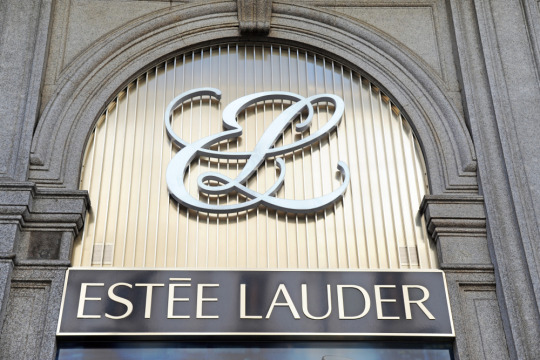
View On WordPress
0 notes
Text
Elijah Rock Sells Out Sapphire Room For His 'Great American Songbook' Debut There Following Outstanding Benefit Show at The Knitting Factory
Elijah Rock Sells Out Sapphire Room For His ‘Great American Songbook’ Debut There Following Outstanding Benefit Show at The Knitting Factory

View On WordPress
#Alzheimer&039;s Foundation of Greater Idaho. Knitting Factory#Alzheimers Foundation#Elijah Rock#Sapphire Room
0 notes
Text
RICE Alzheimer's Research Institute
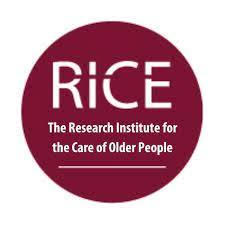

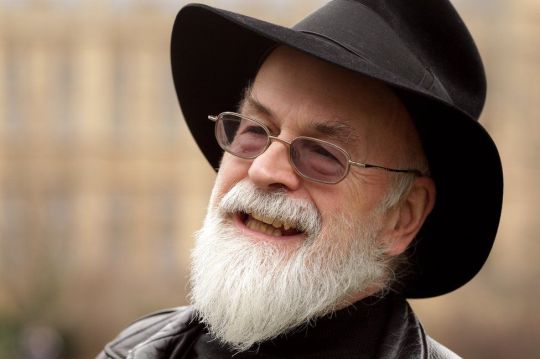
Terry died on 12 March 2015, having given his PCA a run for its money. Open about his diagnosis, he has helped to unlock the secrecy and stigma that often surrounds dementia. His legion of fans is undoubtedly grateful that despite the inevitable progression of the PCA he was able to fight his ‘embuggerance’ and continue to produce a number of both well-received and well-reviewed books. Terry was also a great example to me in emphasizing how important it is that, in caring for people with any type of dementia, we always look for what people with a condition like PCA can still do, rather than what they can’t: by maximizing what is possible, a person can still live well with dementia for a significant time.
--Professor Roy Jones, Director of RICE
(taken from “Terry Pratchett: His World”)
I wanted to post something for the Glorious 25th about the Research Institute for the Care of Older People (RICE) in Bath, where Sir Terry Pratchett received treatment for Post-Cortical Atrophy, the type of Alzheimer's disease that eventually took his life. From the organization's website:
RICE established one of the first memory clinic services in the UK in 1987 – a service which has since been widely replicated and is now considered standard and best practice by the NHS. In fact, RICE now runs the NHS Memory Clinic in Bath and North East Somerset on behalf of the local clinical commissioning group and local authority through a sub-contract with HCRG Care Group. To date, we’ve assessed, diagnosed, treated and advised 12,000 people with memory problems and their families in our memory clinic.
Most of RICE’s clinical services and research activities take place in our own purpose built, specialist centre located on the Royal United Hospital site. The building of the RICE Centre was possible as a result of generous donations from major donors, trusts and foundations, and members of the public. RICE moved into the ground and first floor of the centre in 2008. Following the success of the DementiaPlus Appeal and further generous donations from major donors, trusts and foundations and members of the public, RICE converted the attic floor in 2019 to create more office space. This has given us access to much needed additional rooms and offices which will enable us to grow and run more services and activities. We’ve worked hard to ensure that the areas of the centre visited by our patients meets their needs and we regularly receive feedback on how much our patients enjoy their visit to our centre.
RICE not only provides clinical services to patients, but also conducts research into aging and dementia, including performing clinical trials for new drug treatments for memory-related diseases and developing other "techniques for diagnosing, managing, treating and understanding dementia and memory changes in older adults."
Lady Lyn Pratchett is the patron of the organization, and the website includes a page about how people can donate funds or volunteer at the clinic and participate in fundraising events.
SO, if you'd like to help fund Alzheimer's research on this Glorious 25th of May--or at any time--in honor of the Man in the Hat, take a look!
#terry pratchett#gnu terry pratchett#discworld#the glorious 25th of may#research institute for the care of older people#alzheimer's#signal boosting is appreciated too!
656 notes
·
View notes
Text

oh god ok I just caught up on this and WOW
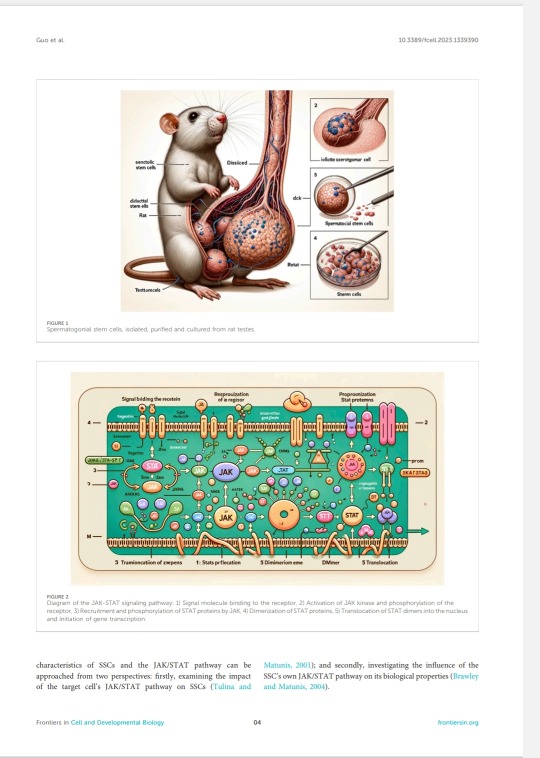

so, thought #1: yeah these are awful lol
thought #2: I don't think AI is going to create a uniquely bad atmosphere for fraud in academic articles, because we've already established the incentives and conditions for fraud to be a substantial problem in the first place
most people heard about the foundational Alzheimer's research that was found to be fabricated, and that was probably the most high profile case in recent years
institutions basically lock PI's in an eternal grant-writing grind where they have to produce interesting, relevant, and novel research continually in order for them and everyone under them to keep their jobs. it de-incentivizes any type of research that seeks to verify or reproduce previous studies (journals generally won't publish this) and if you end up NOT finding something ground-breaking, then it's seen as a scientitic failure rather than a naturally possible outcome of investigating the world, in which things sometimes aren't interesting
this obviously lays incentives for fudging data in the whole field of science itself, but there's been high amount of fraud coming from institutions in china which is why I was disappointed but not especially surprised by this
I'm prefacing this by saying that scientists based in china have been asking for solutions to this and rightly pointing the blame to the uniquely weird government funding scheme as the cause. I'm not going to get too much into it, but there have been issues with fake paper mills for years, and "citation circles" (iirc you can get a cash kickback for how many times you're cited) of people agreeing to cite each other's irrelevant papers.
it's gotten to the point where, and this is really bad, PI's over here will ignore papers that come from china-based institutions under the presumption that the data is unreliable.
excerpt from the article:
For example, in 2017, Tumor Biology published by Springer retracted 107 papers, all of which are by Chinese authors, because authors provided made-up contact information of potential reviewers, and the review processes ended up being manipulated by third-party agencies that make profit from “faking” the review processes (Chen, 2017). Also, certain journals have in recent years witnessed a concentration of works by authors from China. We suspect that this is because of closely knit networks of editors, reviewers and authors, which results in superficial peer-review, easy acceptance, and deliberate self-citing from the same journals to boost impact factors (see Guglielmi, 2019 for similar patterns of behaviors occurring to Italian scientists).
re: the last sentence, it does happen to a lesser degree elsewhere, which is why this is a field-wide problem
the chinese government has I think in recent years realized that the way everything is structured is de-legitimizing their research, and there have been huge efforts to crack down on fraud and basically place sanctions on these scientists. but that's sort of just handling the symptoms and not the cause - I'm not sure how far along they are on rectifying the index by which they ascribe merit and funding potential to PI's (we do this in other ways too) but yeah, the whole system of academia itself has to change.
59 notes
·
View notes
Text
How Funding Affected my Journalism Jobs
The different places I’ve worked as a journalist, and in related fields, have all had different funding. Here are my experiences at different places–and it seems to me that grant-funded stuff is the best.
Internship at Nat Geo
Grants sponsored both of the other interns, but not me. Nat Geo makes a lot of its money through things like books at TV.
Mine was low-paid, but probably normal for an internship in 2016? LOVED the experience. Freelance at Nat Geo afterward was MUCH better paid. $14/hour part-time. IDK how much the grant-funded interns made. 2016.
Fellowship at PBS Newshour
A grant from the National Science Foundation funded me, but PBS is state-sponsored media. Interestingly, that’s a huge red flag in China and Russia, but I found the US-funded Public Broadcasting Service very fair to its subjects. Good experience, but even worse pay, at $13/hour full-time. 2016-2017
Job at Newsweek
Their funding is from clicks. This place was crazy bad and paid garbage. Everyone hated it and almost everyone quit, unless they were being fired for making a living wage. Some people even got fired for accurately reporting on the company itself on assignment from their editors–there was no obscuring it, that was cited as their reason for termitation. Newsweek is Hellfire and damnation. I suspect the nonsense demand for 5 stories/day/person and silly demand that we make them go viral stemmed from the following: the fact that the company primarily made its money from clicks and higher-ups didn’t appear to care about the long-term reputation of the company or its reporters, and perhaps an ego-fueled refusal to try to understand what actually got clicks. $39k/year. 2017-2018
Freelance at VOX
Funded by clicks/ads and grants at the time, but halfway through they started a contribution campaign. The difference I noticed between VOX and Newsweek was that VOX practices were smarter and they actually paid attention to analytics and sane business practices. Also, it's much easier to qualify for and get grants if you're actually doing good journalism, so I don't believe that Newsweek's policy of "lots of garbage" was actually business-savvy in any way.
Vox was a good experience, even though I wasn’t working as a journalist, but doing SEO/social media for journalists. $35/hour, then $50/hour part-time. Then I was laid off due to the pandemic. 2019-2020
Freelance at Alzheimer's Association
Remote, not really journalism, but I liked it anyway. Nonprofit, so, funded by donations and grants. $65/hour part-time. 2021
Job at Bay Nature
My job was entirely funded by a grant. Odd situation–I got the grant and I could bring it to any legit journalism employer. Bay Nature was supposed to contribute 40% of my salary but flexibility happened and they just paid health insurance and such. They got basically no money at all from clicks, like, pennies a year. Not much from subscriptions. They have fundraisers, and at the time, there were 3 writers/editors and 2 fundraisers on staff. Later they hired another writer whose entire salary was paid by a philanthropist, and then I’m told they got another salary funded by a UC Berkeley journalism grant program. So, like half of their editorial staff was grant-funded.
Great experience, but low pay for the Bay Area. $50k/year, all from Poynter-Koch, 2021-2022.
Freelance at Politifact
A nonprofit and they probably get lots of grants. My particular position was also funded by a grant entirely. Loved it. $250/article fact check. 2022.
Book
REALLY love it. $50k is from MIT Press, which is a not-for-profit, and it gets some grants and endowments. Then I got $56k from a grant from the Sloan Foundation on top.
Future?
I also got $500 (plus gas and hotels) to attend a day of learning with a program called Investing in Wyoming’s Creative Economy, and that means I’m one of 100 people eligible to apply for 10 $25k grants for future projects. The idea is to support creatives to stay in Wyoming and have sustainable businesses here. Maybe do some art that will bring in tourists.
_____________________
Note that a grant sort of does, and sort of doesn’t, mean free money. It means money to support a project that usually has to have a mission and a public good, like educating the public. You don’t pay these back, and the org giving the grants doesn’t require a percentage of the profits or anything. But, for instance, the $50k grant from Poynter-Koch was more like a gift to Bay Nature, so they could pay me, and I worked for a year to actually have the funds.
However, I’m not yet convinced that there is any objectively good funding model to ensure the most fair and accurate journalism. In theory, the capitalistic ones would be the best, but the public desire to read inflammatory stories about how their political enemies are evil, or a different generation is full of idiots, adversely affected the accuracy of headlines at Newsweek IMO.
You might think that the worst funding source would be Poynter-Koch, which is a program run by Poynter and funded by the Charles Koch Institute. But neither Poynter nor Koch even asked me to tell them what I was writing, let alone try to stop me from writing it. (Poynter hosted mentor-led auxiliary groups to talk about our careers/lives and such, so the topics of our articles came up sometimes if we chose to share that.)
Anyway, I’m thinking of writing an article on how funding models affect journalism, for better and worse. There are some high-profile examples of grant funding causing harm. But for now, the above is my experience–pretty much all good, except not enough funding sometimes.
59 notes
·
View notes
Text
Maslow’s Hierarchy: A Guide to getting your life together
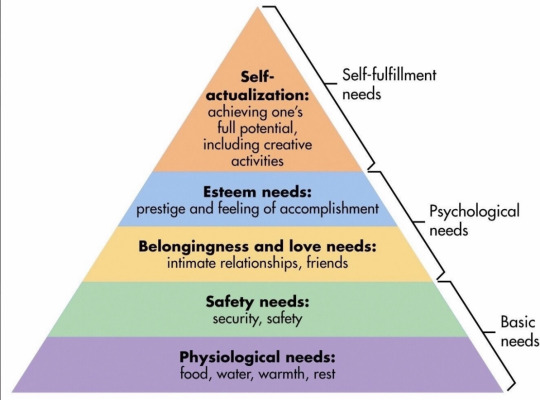
After we get our basic needs, we are often stuck on the getting our psychological needs (love, friendship, and accomplishment).
How to satisfy your psychological needs:
Be part of a community through school, work, or organization. Volunteer at a charity or organization of your choice. By doing so, you can connect with other people, build a sense of camaraderie, and learn more about yourself.
Participate in classes, clubs, or an environment that requires you to be active with the same people, and by proximity you can build friendships.
Set challenges that are within your control and win. Honestly, the easiest way to win is to challenge yourself and overcome that challenge. This will boost your self-esteem. Run a marathon, the barrier of entry is low, and the price you have to pay is discipline. The goal is to have a sense of accomplishment internally before the external ones (promotion, dream school, dream job).
Design a lifestyle that is attractive to others: To have an attractive lifestyle is to be comfortable and confident in your skin. You’ve figured out yourself by then. You have hobbies, you know your strengths, you’re building yourself, you have a passion, and you are curious and optimistic. Once you’ve designed your life, it is easy to know who fits into your new life and only the people who value your growth will come to you.
How to satisfy your self fulfillment needs:
Write down your dream life (I am a business woman, who is a philanthropist passionate about neuroscience and social psychology. I often travel the world to give lectures and I sit on the board of some Fortune 500 companies) only you can decide your dream life.
Break down your dream life into bits and pieces and turn them into actionable steps ( I will apply to be a volunteer at the Alzheimer's foundation. I read books on public speaking, I’d learn about the top fortune 50 companies).
Explore your creative ingenuity: paint, dance, write, practice your guitar. Most times it is during these creative moments that we get an idea of our purpose in life.
Introspect: Journal and find out what your calling is. We all have a calling that is bigger than our own desires. Sometimes, it takes personal experience, exposure, or introspection to figure out something we were called to do and once you’ve figured it, start working on it slowly. It’s a journey.
With Love,
Black Pearl.
#self improvement#self love#mindfulness#motivatedmindset#motivation#mindset#mind control#discipline#motivating quotes#motivating myself#psychotherapy#self care#classy#self help#self development#self control#ideas#love#beauty#growth#determination#level up journey#self growth#self confidence#self care reminder#luxury
551 notes
·
View notes
Text

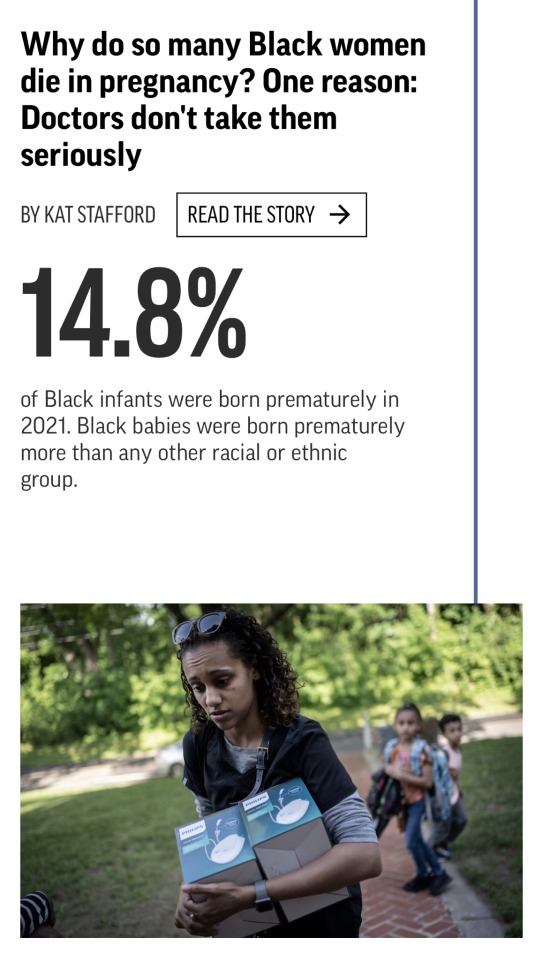


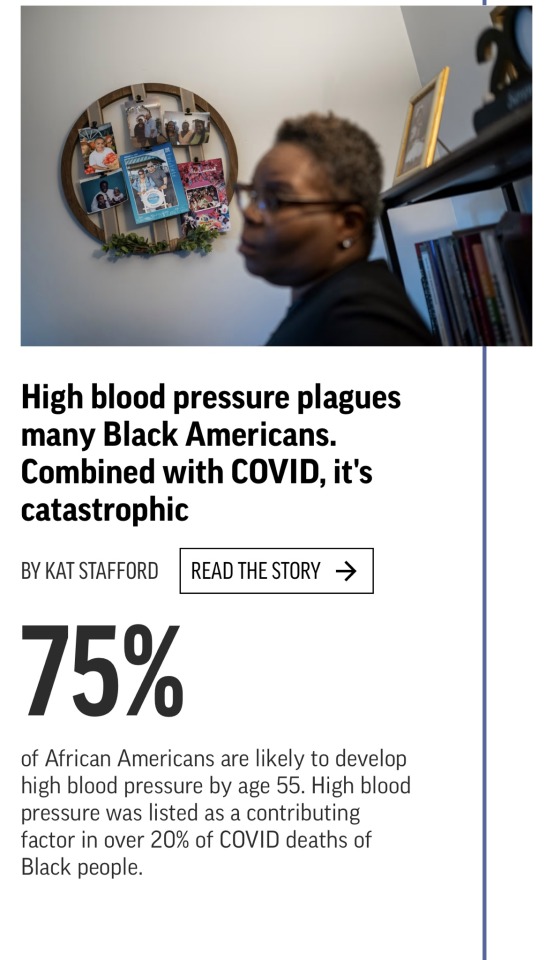



FROM BIRTH TO DEATH, Black Americans fare worse in measures of health compared to their white counterparts. They have higher rates of infant and maternal mortality, higher incidence of asthma during childhood, more difficulty treating mental health as teens, and greater rates of high blood pressure, Alzheimer's disease and other illnesses.
The Associated Press spent the past year exploring how the legacy of racism in America has laid the foundation for the health inequities that Black people face.
Links to each article beneath the “Keep reading” cut
Why do so many Black women die in pregnancy? One reason: Doctors don't take them seriously (link)
Black children are more likely to have asthma. A lot comes down to where they live (link)
Black kids face racism before they even start school. It's driving a major mental health crisis (link)
High blood pressure plagues many Black Americans. Combined with COVID, it's catastrophic (link)
A lifetime of racism makes Alzheimer’s more common in Black Americans (link)
Medical Racism in History (link)
#medical racism#racialized misogyny#structural racism#black history#racism#politics#inequality#healthcare#medical#two americas#double standards#from birth to death#systemic racism#environmental racism
99 notes
·
View notes
Text
There is a fury to Terry Pratchett’s writing: it’s the fury that was the engine that powered Discworld. It’s also the anger at the headmaster who would decide that six-year-old Terry Pratchett would never be smart enough for the 11-plus; anger at pompous critics, and at those who think serious is the opposite of funny; anger at his early American publishers who could not bring his books out successfully.
The anger is always there, an engine that drives. By the time Terry learned he had a rare, early onset form of Alzheimer’s, the targets of his fury changed: he was angry with his brain and his genetics and, more than these, furious at a country that would not permit him (or others in a similarly intolerable situation) to choose the manner and the time of their passing.
And that anger, it seems to me, is about Terry’s underlying sense of what is fair and what is not. It is that sense of fairness that underlies Terry’s work and his writing, and it’s what drove him from school to journalism to the press office of the SouthWestern Electricity Board to the position of being one of the best-loved and bestselling writers in the world.
It’s the same sense of fairness that means that, sometimes in the cracks, while writing about other things, he takes time to punctiliously acknowledge his influences – Alan Coren, for example, who pioneered so many of the techniques of short humour that Terry and I have filched over the years; or the glorious, overstuffed, heady thing that is Brewer’s Dictionary of Phrase and Fable and its compiler, the Rev E Cobham Brewer, that most serendipitious of authors. Terry once wrote an introduction to Brewer’s and it made me smile – we would call each other up in delight whenever we discovered a book by Brewer we had not seen before (“’Ere!’ Have you already got a copy of Brewer’s A Dictionary of Miracles: Imitative, Realistic and Dogmatic?”)
Terry’s authorial voice is always Terry’s: genial, informed, sensible, drily amused. I suppose that, if you look quickly and are not paying attention, you might, perhaps, mistake it for jolly. But beneath any jollity there is a foundation of fury. Terry Pratchett is not one to go gentle into any night, good or otherwise.
He will rage, as he leaves, against so many things: stupidity, injustice, human foolishness and shortsightedness, not just the dying of the light. And, hand in hand with the anger, like an angel and a demon walking into the sunset, there is love: for human beings, in all our fallibility; for treasured objects; for stories; and ultimately and in all things, love for human dignity.
Or to put it another way, anger is the engine that drives him, but it is the greatness of spirit that deploys that anger on the side of the angels, or better yet for all of us, the orangutans.
Terry Pratchett is not a jolly old elf at all. Not even close. He’s so much more than that. As Terry walks into the darkness much too soon, I find myself raging too: at the injustice that deprives us of – what? Another 20 or 30 books? Another shelf-full of ideas and glorious phrases and old friends and new, of stories in which people do what they really do best, which is use their heads to get themselves out of the trouble they got into by not thinking? Another book or two of journalism and agitprop? But truly, the loss of these things does not anger me as it should. It saddens me, but I, who have seen some of them being built close-up, understand that any Terry Pratchett book is a small miracle, and we already have more than might be reasonable, and it does not behoove any of us to be greedy.
I rage at the imminent loss of my friend. And I think, “What would Terry do with this anger?” Then I pick up my pen, and I start to write.
Extracted from Neil Gaiman’s introduction to A Slip of the Keyboard: Collected Non-fiction by Terry Pratchett
24 notes
·
View notes
Text
Yasuke would be SO upset with his research being used as a foundation for Neo World, though.
Yasuke's entire purpose in going into neurology was to help people regain memories, to fight what is implied to be early onset Alzheimer's (from which his mother is implied to have died). His entire thing is about helping people to remember and maintain the memories their mind wants them to lose.
(In this case, the implication that this was used to help the survivors regain their missing memories is on point.)
But the idea that his research would be used to literally strip people of their memories to make them live new lives and then rewrite over those memories is such an affront to his research. It is the exact opposite of what his research was for.
And he would hate both it and everyone who used it for that purpose.
#musings#danganronpa#dr2#dr0#yasuke matsuda#ngl i hate the premise of neo world#i hate it A LOT#that's not how you help people#it bothers me so much that the conclusion is 'let's just reboot them' because like#everything they did still has consequences#they're gonna wake up in a world where all of that still happened#where people will hate them for crimes they never remember committing#like i don't#there's so much wrong with neo world#not the least of is /this/
21 notes
·
View notes
Text
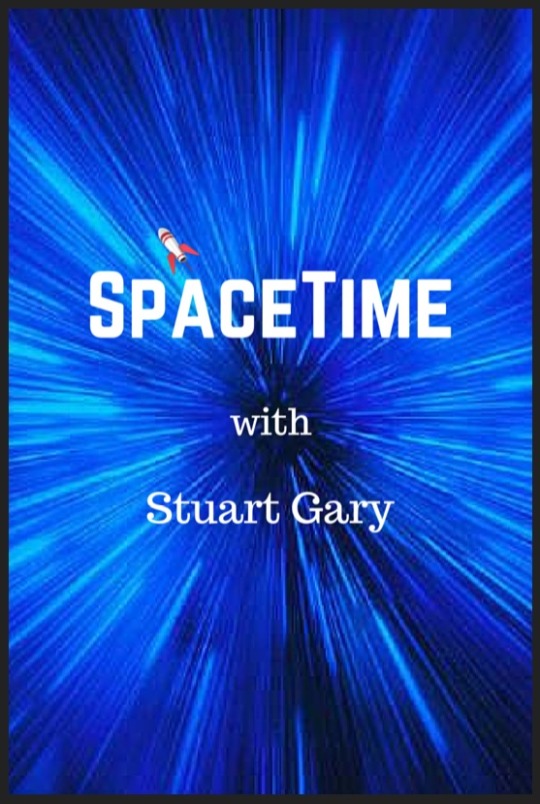
New SpaceTime out Monday....
SpaceTime 20240408 Series 27 Episode 43
Discovery of the faintest known star system orbiting the Milky Way
Astronomers have detected an ancient star system traveling around our Milky Way galaxy which has set a new record as the faintest and lowest-mass satellite galaxy ever discovered.
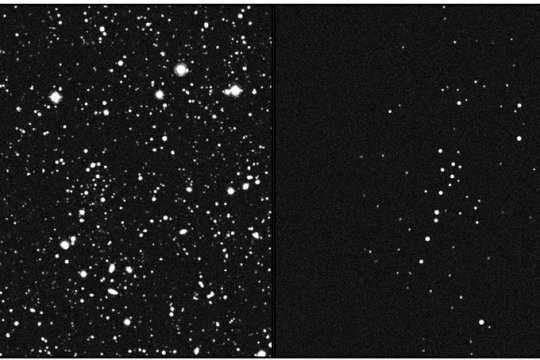
Bowen Orbital Spaceport open for business
Australia’s first privately operated orbital launch facility has been formally opened at Abbot Point near Bowen on the Queensland tropical Pacific coast. The complex is expected to undertake its first launch next month with a Gilmour Space Eris rocket to fly on its maiden flight.











Southern launch getting ready for its next test flight
Southern Launch says its Koonibba Test Range on South Australia’s Eyre peninsula is almost ready for its next test launch in just a matter of weeks.

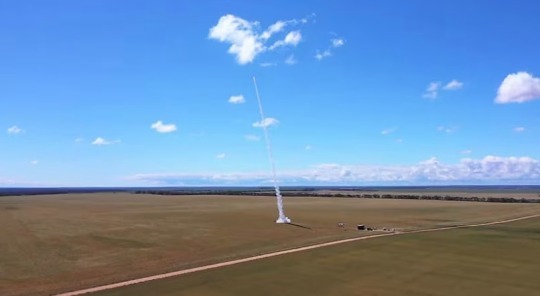

The Science Report
Warnings that Australia could soon see megadroughts lasting over twenty years.
Discovery of a strong link between Alzheimer's and the daily consumption of meat and processed foods.
A new study claims the earliest dinosaurs experienced rapid growth rates.
Skeptics guide belief in psychic powers
SpaceTime covers the latest news in astronomy & space sciences.
The show is available every Monday, Wednesday and Friday through Apple Podcasts (itunes), Stitcher, Google Podcast, Pocketcasts, SoundCloud, Bitez.com, YouTube, your favourite podcast download provider, and from www.spacetimewithstuartgary.com
SpaceTime is also broadcast through the National Science Foundation on Science Zone Radio and on both i-heart Radio and Tune-In Radio.
SpaceTime daily news blog: http://spacetimewithstuartgary.tumblr.com/
SpaceTime facebook: www.facebook.com/spacetimewithstuartgary
SpaceTime Instagram @spacetimewithstuartgary
SpaceTime twitter feed @stuartgary
SpaceTime YouTube: @SpaceTimewithStuartGary
SpaceTime -- A brief history
SpaceTime is Australia’s most popular and respected astronomy and space science news program – averaging over two million downloads every year. We’re also number five in the United States. The show reports on the latest stories and discoveries making news in astronomy, space flight, and science. SpaceTime features weekly interviews with leading Australian scientists about their research. The show began life in 1995 as ‘StarStuff’ on the Australian Broadcasting Corporation’s (ABC) NewsRadio network. Award winning investigative reporter Stuart Gary created the program during more than fifteen years as NewsRadio’s evening anchor and Science Editor. Gary’s always loved science. He studied astronomy at university and was invited to undertake a PHD in astrophysics, but instead focused on his career in journalism and radio broadcasting. He worked as an announcer and music DJ in commercial radio, before becoming a journalist and eventually joining ABC News and Current Affairs. Later, Gary became part of the team that set up ABC NewsRadio and was one of its first presenters. When asked to put his science background to use, Gary developed StarStuff which he wrote, produced and hosted, consistently achieving 9 per cent of the national Australian radio audience based on the ABC’s Nielsen ratings survey figures for the five major Australian metro markets: Sydney, Melbourne, Brisbane, Adelaide, and Perth. The StarStuff podcast was published on line by ABC Science -- achieving over 1.3 million downloads annually. However, after some 20 years, the show finally wrapped up in December 2015 following ABC funding cuts, and a redirection of available finances to increase sports and horse racing coverage. Rather than continue with the ABC, Gary resigned so that he could keep the show going independently. StarStuff was rebranded as “SpaceTime”, with the first episode being broadcast in February 2016. Over the years, SpaceTime has grown, more than doubling its former ABC audience numbers and expanding to include new segments such as the Science Report -- which provides a wrap of general science news, weekly skeptical science features, special reports looking at the latest computer and technology news, and Skywatch – which provides a monthly guide to the night skies. The show is published three times weekly (every Monday, Wednesday and Friday) and available from the United States National Science Foundation on Science Zone Radio, and through both i-heart Radio and Tune-In Radio.
#science#space#astronomy#physics#news#nasa#esa#astrophysics#spacetimewithstuartgary#starstuff#spacetime#galaxy#nasa photos#jwst
14 notes
·
View notes
Text
File: OC 17
SCP#: ADW
Code Name: Dusty the Healing Cat
Object Class: Thaumiel
Special Containment Procedures: SCP-ADW has been assigned to Mobile Task Force Demeter-4 "Animal Control". When she is on a mission, she is kept at the established recon tent to assist the medical team, this mainly applies for major missions.
When not assigned to a mission SCP-ADW is "contained" as Site-AM. SCP-ADW is allowed to wander the halls, cafeteria, the lobbies and other areas accessible to Level 1 Clearance staff and lower. SCP-ADW has been given a collar to keep her out of restricted and dangerous areas. Each area has been given transmitters that activate when her collar is close enough. It will release a frequency tricking her brain into thinking there is a barrier in front of her preventing her from going beyond the restricted area. It should be noted that this is the same method used to keep other anomalous animals in Foundation custody safe.
Foundation staff are to either treat SCP-ADW kindly by giving her pets and allowing her to eat the crumbs of their food. However, if a Foundation staff member sits down and find SCP-ADW walking up to them and sleeping on their shoulder or lap they are to remain sitting until SCP-ADW gets off of her own volition. Foundation staff that don't like cats are advised to follow the containment procedures or at the very least just avoid SCP-ADW. Any Foundation staff that show hostility or even harm SCP-ADW are to be demoted by a single level and provide SCP-ADW a meal as an apology, there are no exceptions.
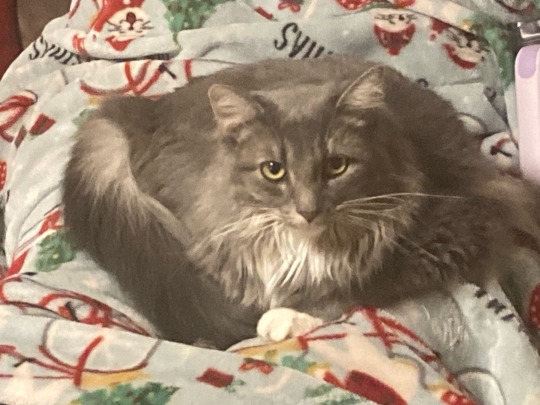
Picture of SCP-ADW while curled up on Agent Zato's lap and utilizing its anomalous effects on her.
Description: SCP-ADW is an adult house cat with grey fur and yellow eyes, DNA testing shows she just a normal member of Felis Catus species. SCP-ADW has the anomalous ability to heal anyone she sleeps on with 100% accuracy. Furthermore, when SCP-ADW rests on someone's lap or shoulder, they feel a sense of easy and reduction of anxiety as a whole. Mental conditions such as ADHD and Aspergers have been known to fade after repeated exposure with SCP-ADW and even lead to the brain expanding in memory, learning speed, and reduce chances of developing Alzheimer's disease.
SCP-ADW is very moody, and hates being picked up so to activate her anomalous abilities its always best to let her come to you instead. SCP-ADW has an anomalous sense to be able to see the true nature of people and often hisses at those that have or are destined to committee horrific atrocities. Given the questionable actions of most Foundation staff ethics wise, it's surprising that SCP-ADW even tolerates the staff at all. Though thankfully this anomalous ability of SCP-ADW has allowed Foundation staff to detect spies that somehow manage to get into Site-AM. It's because of SCP-ADW's sense and her ability to heal those she sleeps on is why she is labeled as Object Class Thaumiel.
SCP-ADW was discovered in 2022 by a Foundation agent named Zato. Agent Zato was off work and driving home when she stumbled across a dirty kitten on the road. She picked it up, took it home, cleaned the kitten, and named it Dusty. She was still suffering from pain from a bullet wound she got a week prior from a mission. SCP-ADW walked up to her and slept on her lap. After SCP-ADW left Agent Zato noticed she was feeling better, and the scars form her past wounds were gone. Agent Zato reported this to the higher ups immediately and brought SCP-ADW to the nearest Foundation Area base where her anomalous abilities were tested and revealed.
At the same time, it was revealed that one of the researchers there was a member of the Serpents Hand. He was trying to get promoted through the Foundation ranks to get his hands on more anomalous items and steal them all in one go. This was discovered when SCP-ADW kept hissing at him, and Agent Zato requested there be a more in-depth background check on him. After extensive research his origin was discovered, and he was apprehended by Foundation security. Because of this SCP-ADW is now considered a highly valuable asset to the Foundation and was sent to Site-AM. Agent Zato was given a position as security of Site-AM so that she could avoid further harsh missions and continue to be with SCP-ADW as the primary caretaker.
.
SCP: Horror Movie Files Hub
#DZtheNerd#SCP: Horror Movie Files#SCP Foundation#SCP Fanfiction#SCP AU#SCP#SCP OC#scp mtf#Mobile Task Force Demeter-4 “Animal Control”#SCP-ADW#Site-AM#Thaumiel#cat post#tumblr cats#kitten#cats of tumblr
11 notes
·
View notes
Text
This was going to be part of my costume meta (which I’m still working on!) but it is too epic to get lost in the big post - I’ll link to this one in the main meta. This little discovery gains more significance after listening to the interview Oliver gave earlier - I’ve linked the @911bts post in case you haven’t heard it.
So Kitchen scene from 6x01 - Buck is wearing a white tee - and we’ve long established that Buck and white tops means trouble! in this instance the trouble is present in the scene - its his tantrum over being passed up for interim captain and actually reflects nicely on to the turmoil his mind is currently in in relation to his personal life with all the loaded sentences about couches and and relationships.
Then there is the the mid to light blue zip front shirt with vertical stripes and a yellowed tint to it - which is a lightweight cotton denim. Its this denim zip shirt I want to talk about because when I realised its significance I gasped (and freaked the person I was sitting net to out) and have spent the rest of today flapping over it.

I was initially intrigued because we never see buck in denim and then I remembered we have seen him in a denim shirt - just the once - a western style one pictured below which also has a yellowed tint to it!
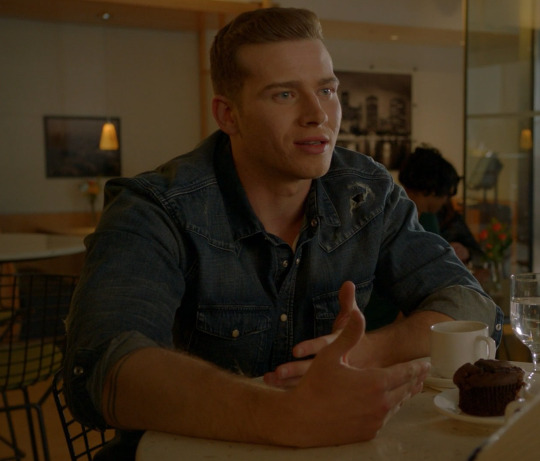
This is the only time we have seen Buck wearing a denim shirt until 6x01 (incidentally he is also wearing a white shirt underneath it and the sleeves are rolled up in a similar manner. He’s worn a few different denim jackets etc, but never another shirt.
I was intrigued by this and then I remembered the full context!!! That western style denim shirt was the one he wore for his coffee shop date with Abby at the end of 1x09. The reason I gasped at this parallel that the costume team have made here hits on a few different levels. Firstly 1x09 is the only other time that blimps are mentioned in 911!! Yes indeed that coffee shop date comes after the failed hot air balloon date and that locker room talk with bobby about blimps and stepping in with someone in a relationship. So not only do we have the blimp parallel, we also have a Buck and Bobby talk in both episodes.
That coffee shop date is when we see Buck really starting his first serious relationship - seeing all the things that come with dating Abby (her Mom’s Alzheimer's for example) - and choosing to embrace them (dare I say that this is the Buck 1.5 KR was speaking about in her interview!) and stepping in for all the difficult stuff. That date was a foundation stone for Buck - what he learnt from that relationship is still present today in what he has been building with Eddie - it was a moment of growth for him and a lesson he took to heart and continues to live by to this day - stepping into Eddie’s mess and supporting him time and again. the difference between them is obvious Abby wasn’t truly interested in building a true relationship where as Eddie has been from the off - he continues to let Buck into places no one else has been allowed.
So here we are post 6x01 with a scene so laden with metaphors and multiple meanings, where body and facial language are very loud in another episode where a there is a blimp in some form. Only this time we have an actual blimp rather than a mentioned one that was actually a mix up with a hot air balloon by Bobby. Bobby who gave the advice which Buck took to heart in 1x09 and which has had far reaching consequences and Bobby who gives Buck more advice in 6x01 which is likely to have far reaching consequences and intertwines with the advice from 1x09.
The fact that the costume team have drawn this parallel won’t be by chance - it will have been discussed at length in production meetings - its like a repeat outfit - only better - repeat outfits are just that - a repeat - they directly invoke the previous time it was worn and suggests a lack of change - the idea of making the same mistakes again whereas a similar outfit used in the same way as a repeat outfit in this specific way (it only works in situations where the character doesn’t normally wear a particular type of clothing like this one where Buck doesn’t wear denim shirts) shows growth - as well as the parallels that can be drawn between the scenes. Ergo Buck is not the same person as he was in 1x09, he has grown. this use of costume and colour (remember the yellow tint I mentioned that both shirts have - well that plays into the yellow and blue colour theory) is a physical and visual way of stating the aims of the show, about the intent of the writers and adds an additional layer to that kitchen scene and only adds further weight to the acting choices - and they all add up to Buddie going canon! this is why Oliver comparing Abby and Eddie in that interview is so interesting and significant.
tagging a few people who I know will be interested (and some of whom had to deal with me screaming at them about this 😂)
@girldadbuddie @livingwherethesidewalkends @lovecolibri @loveyourownsmiilee @xxfiction-is-my-realityxx @mistmarauder @theladyyavilee @leothil @extasiswings @yramesoruniverse @kitkatpancakestack @ktinastrikesback @trashendence @burnthatbridge @fiona-fififi
#come scream with me at the insane way this show uses all of the tools at its disposal#they literally never miss#theyre insane for doing this#this is insane and I'm still not over it#911 costume meta#911 costumes#kym costume theory#mini costume meta#kym costume meta#911 spoilers#911 parallels#911 on fox#buck#bucks costumes#Eddie#abby#buddie#911onfox
162 notes
·
View notes